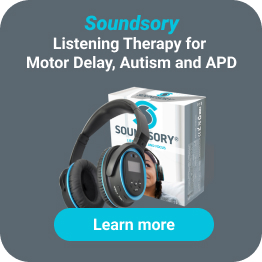How can music therapy for autism help your child? | A Comprehensive Guide
 Rachel Ann Melegrito
Rachel Ann Melegrito Occupational Therapist
July 26, 2024
Introduction
Music is a big part of our lives. We enjoy it when we sing, listen, create, or play music. Beyond the enjoyment, it also helps us express ourselves, learn, and achieve self-regulation. Music is universal – it impacts people of all abilities, including autistic children.
Autism, or autism spectrum disorder (ASD), is a developmental condition characterized by distinct challenges in communication, behavior, and interaction with others [1]. Music therapy is an intervention where a therapist uses musical experiences and the relationships formed through these experiences to address an individual’s needs. Because it is a great medium for communication, social attachment, and cooperation, music, in the form of music therapy, is a great way to address the core problems of autistic children [2].
This article looks into music therapy for autism. We explore how it works, learn its benefits for children with autism, and see what current research says about its effectiveness. We also discuss how to find a music therapist and what to consider when choosing one.
Key Take-Away Messages
| How can music therapy help children with autism? |
| Music therapy, an excellent tool for communication and self-expression, is particularly effective in addressing areas often challenging for children with autism. These areas include: Social interaction and communicationSelf-expressionMood and behavior managementSensory, motor, and perceptual skills |
Try Soundsory®, a unique blend of music and movement therapy, to enhance your child’s neurodevelopment.
What is Autism?
Autism is a developmental disability characterized by two core difficulties: restricted, repetitive patterns of behavior, interests, and abilities, as well as challenges in social interaction and communication [3]. It is called a spectrum disorder because its presentation is different for every autistic person, and therefore, have varying abilities, challenges, and needs.
It is called a developmental disorder because it is a lifelong condition that begins before age three, but symptoms may improve over time [4]. One in 36 children has autism [5]. It is also four times more common in boys than girls [5].
How Does Music Therapy Work?
Music therapy uses music to achieve specific goals a therapist identifies based on a child’s behavior, interactions, and skill assessment. Music for autistic children can help target areas like behavior, sensorimotor, social and communication skills, and cognitive and academic abilities [6].
Therapists with specialized academic and clinical training design personalized programs with tailored interventions to meet each child’s needs [7]. They also design and implement highly individualized treatment programs using interventions, programs, and strategies suited to meet the child’s needs and goals. They also use relationships to create a positive environment for development, whether between the child and therapist, another child, their family, or the music itself.
Music therapy for autism is either active, involving direct engagement in music-making, or passive, focused on listening [8]. In clinical practice, music therapists use four main methods or their combination [9]:
- Listening: involves listening to live or recorded music. Therapists can use listening to relax, activate an individual, or offer them a chance to dance or move to the music. It can also serve as a starting point for discussing and processing emotions.
- Improvisation: This is the spontaneous creation of music using voice, body, simple instruments, or even elements of the environment. It can be a solo or group activity and is an excellent way to encourage connection, emotional expression, social interaction, and self-expression.
- Recreation: involves playing or singing pre-existing music, like a favorite song. By recreating well-known tunes, individuals can enhance motor skills, social skills, relaxation, memory, and other skills.
- Composition: involves a music therapist assisting clients in creating their own music. This could include writing and performing songs, creating lyrics, or crafting instrumental pieces.
The Research on Effectiveness
Music is a form of communication and expression, even for children with severe physical, intellectual, and emotional challenges, such as those with autism [10]. These children are often able to respond to music, making it a valuable means for them to express themselves and communicate. At the same time, many children with autism express great interest in music and have superior musical abilities, causing music therapy to stand out as an intervention for them [11].
A systematic review and meta-analysis conducted in 2022 revealed that music therapy can enhance social skills in children with autism, as evidenced by increased social reactions [12]. However, the studies from randomized controlled trials did not reach a consensus regarding the long-term persistence of these effects [12].
Meanwhile, a 2022 Cochrane review that included 26 studies reviewed the short and medium-term effects of music therapy for autistic people, both in individual and group settings [7]. The review found that compared to placebo and standard care, music therapy was more likely to positively affect global improvement, quality of life, and total autism severity [7].
Another 2022 systematic review that looked into the effectiveness of music therapy for ASD, depression, and other conditions found that for autism, music therapy improved social communication, behavior, parent-child relationship, and brain connectivity [13]. Similarly, a 2016 systematic review and meta-analysis showed that music therapy improves an autistic child’s mood, behavior, language, sensory perception, and social skills [11].
Its effectiveness extends beyond the individuals. For instance, mothers perceived that music therapy had positive long-term benefits in social relationships within the family, enriching both the child and the family’s quality of life [14].
Specific Benefits of Music Therapy for Autism
Improves social skills
Children with autism often find social interaction challenging. However, their special connection to music and ability to engage with it can help overcome these challenges and even lead to improvements. Because of music’s intrinsic reward value, it can encourage children with autism to learn social behaviors and engage in social functions [12,15]. To be specific, it helps improve these aspects of social interaction for kids with autism [12]:
- social participation
- emotional involvement
- joint attention
- peer interactions
- social relationships
- cognitive social skills
Provides means for communication
Music can be used to express and communicate. Music therapy necessitates using particular behaviors needed in communication, such as joint attention, turn-taking, and eye contact. In music therapy, kids are encouraged to practice important communication skills like focusing together on something (joint attention), taking turns, and looking at each other (eye contact) [9]. Music therapy allows these children to learn and better understand, reply to, and keep up interactions with other kids [10].
Aside from these, music therapy can also improve a child with autism’s skills in the following areas:
- behavior
- mood
- cognition
- sensory, motor, and perceptual skills
Finding a Music Therapist
When choosing a music therapist, it’s essential to check their qualifications. They should have at least a bachelor’s degree in music therapy from a program approved by the American Music Therapy Association (AMTA). After their degree, they must pass a national examination to become a Music Therapist – Board Certified (MT-BC). These professionals work in various places like outpatient clinics, medical hospitals, rehabilitation facilities, schools, and private practice.
Another important factor to consider is their experience. It’s crucial to find someone with experience working with children with autism. You can ask your pediatrician, therapist, school teacher, or other professionals working with your child for a referral. Alternatively, you can try to find a qualified music therapist by checking AMTA’s online directory or contact them via email (findMT@musictherapy.org) or phone (301-589-3300). A quick online search for the keyword “music therapy for autism near me” should also yield relevant results.
Combining Music Therapy with Other Treatments
Currently, there isn’t a one-size-fits-all treatment for autism, as it affects each child differently. Given the diverse range of challenges, skills, and abilities in children on the autism spectrum, their treatments and interventions need to be tailored specifically to each individual. Despite this variation, there are several therapies and interventions available that can aid children with autism. Typically, children receive a combination of these therapies [16]:
- Occupational therapy
- Physical therapy
- Speech-language therapy
- Cognitive behavior therapy
- Behavior management therapy
- Medications
- Social skills training
- Educational and school-based therapies
Music therapy can be used in combination with these treatments. Particularly, programs like Soundsory® and Forbrain® can greatly complement traditional treatments for autism as well as music therapy. Soundsory® combines music with movement-based activities to provide individuals with multisensory input to improve posture, balance, spatial orientation, attention, and cognitive skills. Soundsory® can complement music therapy sessions focused on recreating and improvising sounds. Similarly, Forbrain® uses filters to enhance the child’s voice before sending it back to the brain to stimulate the auditory system. In turn, the enhanced spoken language enhances self-awareness, fluency, comprehension, and memory. Using this device can significantly benefit children as they recreate or compose music.
A Real World Example with Soundsory Music Therapy headphones
“I love that Soundsory from Sound for Life Ltd is both useful and therapeutic. It’s a music-based program that improves motor and cognitive skills, using bone conduction technology and specially designed music. It’s meant to be used for 30 minutes a day over 40 days.”
Our Experience
“I believe in neuroplasticity—the brain’s ability to form new connections. This idea guided me with my son, diagnosed as severely autistic and non-verbal. Thanks to neuroplasticity, he’s now a typical teenager, though he still has behavior and sensory issues. I also care for his 6-year-old half-sister, who is also severely autistic and non-verbal. I was excited to see how they’d react to Soundsory.
The program is built into special headphones, which can also be used as Bluetooth headphones. My son used them daily, gradually adjusting to the 30-minute sessions. My stepdaughter found it harder to tolerate the full 30 minutes.
Despite challenges, my stepdaughter’s ability to follow directions improved with Soundsory. My son enjoyed the physical activities. Both children enjoyed the music, and we noticed it helped them focus better on schoolwork, as if Soundsory prepared their brains to learn.
Overall, we’re very pleased with Soundsory. The improvement in both kids’ attention and my stepdaughter’s progress is impressive. The device’s versatility as Bluetooth headphones is a bonus. I definitely recommend Soundsory to others.”

Soundsory Client
Conclusion
Music therapy provides valuable support for children with autism, addressing core challenges like social skills, communication, and emotional expression. Given the often observed natural inclination and positive reaction of many children with autism to music, this therapy can be an integral component of their overall care strategy. Expert music therapists tailor interventions to each child’s specific needs. If you’re considering music therapy for your child, discuss it with their doctor to explore how it can complement other treatments and support your child’s goals and progress.
FAQs
Does music therapy work for autism?
Numerous reviews show that individuals with autism benefit from music therapy. One showed that it can improve their language, sensory perception, mood, behavior, and social skills [11]. Meanwhile, another study showed that the therapy positively impacts global improvement, quality of life, and total autism severity [7].
What kind of music is best for autism?
The type and characteristics of music most beneficial for autistic people depend on their interests and the specific goals you want the music to achieve. Slow, rhythmic music is often used to encourage self-regulation and alleviate anxiety, while more upbeat and louder music can be effective in stimulating an under-stimulated nervous system.
How does sound therapy help autism?
Sound therapy can address a wide range of skills in children with autism. This can include attention, memory, self-expression, sensory processing, self-regulation, cognition, postural control, motor skills, and more.
References
- National Institute of Mental Health. (February 2024). Autism spectrum disorder. https://www.nimh.nih.gov/health/topics/autism-spectrum-disorders-asd
- Koelsch, S. Brain correlates of music-evoked emotions. Nat Rev Neurosci 15, 170–180 (2014). https://doi.org/10.1038/nrn3666
- Mughal, S., Faizy, R., & Saadabadi, A. (2022). Autism spectrum disorder. Statpearls. Retrieved March 30, 2024, from https://www.ncbi.nlm.nih.gov/books/NBK525976/
- Centers for disease control and prevention. (December 2022). What is autism spectrum disorder? https://www.cdc.gov/ncbddd/autism/facts.html
- Centers for disease control and prevention. (2023). Data & statistics on autism spectrum disorder. https://www.cdc.gov/ncbddd/autism/data.html
- American music therapy association. (2005). What is music therapy? https://www.musictherapy.org/about/musictherapy/
- Geretsegger, M., Fusar-Poli, L., Elefant, C., Mössler, K. A., Vitale, G., & Gold, C. (2022). Music therapy for autistic people. The Cochrane database of systematic reviews, 5(5), CD004381. https://doi.org/10.1002/14651858.CD004381.pub4
- McPherson, T., Berger, D., Alagapan, S., & Fröhlich, F. (2019). Active and passive rhythmic music therapy interventions differentially modulate sympathetic autonomic nervous system activity. Journal of music therapy, 56(3), 240–264. https://doi.org/10.1093/jmt/thz007
- Stegemann, T., Geretsegger, M., Phan Quoc, E., Riedl, H., & Smetana, M. (2019). Music therapy and other music-based interventions in pediatric health care: An overview. Medicines, 6(1), 25. https://doi.org/10.3390/medicines6010025
- Bharathi, G., Venugopal, A. & Vellingiri, B. Music therapy as a therapeutic tool in improving the social skills of autistic children. Egypt J Neurol Psychiatry Neurosurg, 55, 44 (2019). https://doi.org/10.1186/s41983-019-0091-x
- Zhi-Min Shi, Gui-Hong Lin, Qing Xie, Effects of music therapy on mood, language, behavior, and social skills in children with autism: A meta-analysis, Chinese Nursing Research, 3(3), 137-141. https://doi.org/10.1016/j.cnre.2016.06.018
- Ke, X., Song, W., Yang, M., Li, J., & Liu, W. (2022). Effectiveness of music therapy in children with autism spectrum disorder: A systematic review and meta-analysis. Frontiers in psychiatry, 13, 905113. https://doi.org/10.3389/fpsyt.2022.905113
- Gassner, L., Geretsegger, M., & Mayer-Ferbas, J. (2022). Effectiveness of music therapy for autism spectrum disorder, dementia, depression, insomnia and schizophrenia: update of systematic reviews, European Journal of Public Health, 32(1), 27–34. https://doi.org/10.1093/eurpub/ckab042
- Thompson, G. (2017). Long-term perspectives of family quality of life following music therapy with young children on the autism spectrum: A phenomenological study. Journal of Music Therapy, 54 (4). 432–459. https://doi.org/10.1093/jmt/thx013
- Sharda, M., Tuerk, C., Chowdhury, R. et al. (2018). Music improves social communication and auditory–motor connectivity in children with autism. Transl Psychiatry 8, 231. https://doi.org/10.1038/s41398-018-0287-3
- National institutes of health. (April 2021). Early intervention for autism. https://www.nichd.nih.gov/health/topics/autism/conditioninfo/treatments/early-intervention



